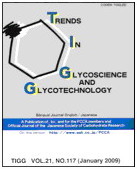All issues

Volume 23 (2011)
- Issue 134 Pages 257-
- Issue 133 Pages 201-
- Issue 132 Pages 161-
- Issue 131 Pages 111-
- Issue 130 Pages 67-
- Issue 129 Pages 1-
Volume 23, Issue 133
Displaying 1-5 of 5 articles from this issue
- |<
- <
- 1
- >
- >|
MINIREVIEW
-
Jessica C.F. Kwok, Chin Lik Tan, Difei Wang, Janosch Heller, James W. ...Article type: MINIREVIEW
2011Volume 23Issue 133 Pages 201-211
Published: 2011
Released on J-STAGE: November 02, 2011
JOURNAL FREE ACCESSChondroitin sulfate proteoglycans (CSPGs) are large extracellular matrix molecules which are highly upregulated in the glial scar after injury to the nervous system. They are mostly inhibitory and have been shown to hinder regeneration of axons across lesions. The removal of CPSGs with bacterial enzyme chondroitinase ABC improves axonal regeneration. In addition, CSPGs are a major component of perineuronal nets, which control plasticity in the CNS, and their removal enhances structural plasticity resulting in an increase in functional recovery. In this review, we shall discuss the role of CSPGs in axonal regeneration and plasticity after nervous system injury and how recent discoveries of CSPG receptors and interacting partners may shed new insights onto the function of these inhibitory molecules.View full abstractDownload PDF (4082K) -
Kazuma Sakamoto, Kenji KadomatsuArticle type: MINIREVIEW
2011Volume 23Issue 133 Pages 212-220
Published: 2011
Released on J-STAGE: November 02, 2011
JOURNAL FREE ACCESSKeratan sulfate (KS) is one of the glycosaminoglycans (GAGs), a family of polysaccharides consisting of repeats of disaccharide units. KS covalently attaches to scaffold core proteins to yield keratan sulfate proteoglycans (KSPGs). Because KSPGs were originally identified in corneal extracts and later shown to be prevalent in cartilage, most research efforts have been focused on their structures and biological functions in these tissues. In the 1980s, KSPGs were found in the central nervous system (CNS), and thus its significance in neuronal development and certain pathological conditions has also been explored. Recent data provide several lines of evidence that KSPG is involved in both physiological and post-injury neuronal plasticity.View full abstractDownload PDF (1374K) -
Chihiro Sato, Ken KitajimaArticle type: MINIREVIEW
2011Volume 23Issue 133 Pages 221-238
Published: 2011
Released on J-STAGE: November 02, 2011
JOURNAL FREE ACCESSPolysialic acid (polySia), particularly α2,8-linked polyNeu5Ac (DP=8∼400), is a unique polymer that spatio-temporally modifies neural cell adhesion molecule (NCAM), predominantly in embryonic brains. PolySia is considered to function as a negative regulator of adhesion between cells, and between cells and extracellular matrix due to its extremely polyanionic nature and steric hindrance. Through its anti-adhesive property and spatio-temporal expression, polySia is involved in cell migration, neural outgrowth, axonal guidance, synaptic plasticity, and the development of normal neural circuits and neurogenesis. Due to improvements of polySia-detection methods, it has been shown that polySia expression persists in the hippocampus and olfactory bulb of adults, where neurogenesis is ongoing; however, the functions of polySia, particularly in adult brains, remain incompletely resolved. Recently, we demonstrated that polySia functions not only as an anti-adhesive molecule, but also as a reservoir for specific bioactive molecules, such as neurotrophic factors, neurotransmitters, and growth factors, which regulate neural function. In addition, studies have revealed that the enzymatic activity of STX, which is involved in the synthesis of polySia, derived from schizophrenic patient is low and that the product of the enzyme, polySia on NCAM is impaired with respect to both quantity and quality. Notably, impaired polySia-NCAM cannot effectively retain bioactive molecules, including BDNF, dopamine, and FGF2. Taken together, the impairment of polySia might influence the retention function of polySia and lead to the development of psychiatric disorders, such as schizophrenia, which are reported to express either lower or elevated amounts of polySia compared with normal brains.View full abstractDownload PDF (2706K) -
Shinji Miyata, Hiroshi KitagawaArticle type: MINIREVIEW
2011Volume 23Issue 133 Pages 239-247
Published: 2011
Released on J-STAGE: November 02, 2011
JOURNAL FREE ACCESSExperience-dependent neuronal plasticity is most evident during a critical period, a limited time in early life, after which neurons become less plastic. Removal of chondroitin sulfate proteoglycans (CSPGs), components of the brain extracellular matrix, reactivates neuronal plasticity in adult animals after the termination of the critical period; therefore, CSPGs long have been recognized as non-specific physical barriers that limit neuronal plasticity. In contrast, recent studies provide evidence that CSPGs may have specific effects on neuronal connectivity; a sulfation code of on chondroitin sulfate (CS) chains that is specified by specific CS sulfation modifications may encode functional information on CSPGs that regulates neuronal plasticity. During postnatal development, CSPGs form perineuronal nets around parvalbumin-expressing inhibitory interneurons, and these neurons are key players in experience-dependent plasticity. Here, we review recent studies on the roles of CSPGs in experience-dependent plasticity, focusing on the relationship between the CS sulfation code and functional maturation of inhibitory interneurons.View full abstractDownload PDF (1245K) -
Takashi YamanakaArticle type: MINIREVIEW
2011Volume 23Issue 133 Pages 248-255
Published: 2011
Released on J-STAGE: November 02, 2011
JOURNAL FREE ACCESSEquine influenza A virus (EIV) is one of the most important pathogens in horses because of its high contagiousness. Like other influenza A viruses, EIV binds to the target cells of the host via interaction between its hemagglutinin and the terminal sialic acid of the cell surface receptor. In 2004 in the United States (US), there was an outbreak of respiratory disorders among dogs caused by the interspecies transmission of EIV. The EIV-derived virus has spread rapidly and has likely become enzootic in dogs in the US. This work reviews current knowledge about the pathogenesis and receptor binding characteristics of the EIV and the EIV-derived virus isolated from a diseased dog in the US.View full abstractDownload PDF (1353K)
- |<
- <
- 1
- >
- >|